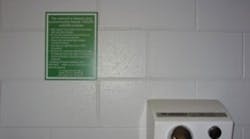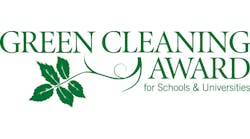The green cleaning program at Central Michigan University began in 2007 with the purchase of the book Green Cleaning for Dummies. The first Green Model Report was printed in February 2008. The program began with only one certified green product but now it has 23 EPA and 11 Green Seal-certified products.
The first step was eliminating unnecessary products, especially aerosols, and replacing products with greener alternatives. Since 2007, it has eliminated more than 35 chemicals. In 2008, it introduced color-coordinated microfiber cloths and mops. The cloths replaced all disposable paper products used for cleaning, saving more than $17,000 annually. About 40 hand driers also were installed in high-volume restrooms to minimize paper towel use. Ninety-nine of paper towel and plastic liner purchases meet or exceed EPA certification requiring products to be made with at least 10 percent recycled content. The eight core chemicals are shipped in concentrated forms to reduce packaging waste and shipping cost. Custodians have dilution control systems on every floor of 130 buildings used for mixing their chemicals. The systems are tested at random quarterly to ensure correct mixing dilutions. Outside windows are cleaned with a window-washing machine that uses only deionized water. All buildings utilize inside door matting and have low-mercury lighting. Monthly graphs that track the amount spent on green and non-green products are produced for every building. Custodians are required to attend quarterly communication meetings and receive 24 hours of training a year. In summer of 2010, the school loaded all academic buildings into a software program to help manage custodial workloads.
The program’s goal is to protect the health of the building occupants, visitors and custodians, as well as reducing polluting effects on air and water. It also stresses the importance of making changes that will save money. In 2007, the supplies expense was $296,219.44; in 2010, it was $209,128.63--a 29.4 percent decrease. Eliminating products and moving to greener products has saved more than $87,000.
Custodians at CMU know that cleaning for health comes before cleaning for appearance, and they play an important role in communicating health safety to building occupants. In September 2009, custodians viewed a special presentation about the H1N1 virus hosted by health services where they could ask questions of a registered nurse. All custodians were given two large signs to display in all of their restrooms, stressing the importance of washing hands and the symptoms of H1N1. In 2009, the school installed more than 100 hand sanitizer dispensers to prevent the spread of germs in computer labs. They also changed the locker/shower room cleaning strategy from once-a-day to twice-a-day as a result of MRSA concerns. In May 2010, the school purchased 500 stickers for all restrooms that states “Please Wash Your Hands! To protect your health and the health of others.”
Waste reduction is very important to CMU, which is why it has an extensive recycling program. Newspaper, magazines, cardboard, aluminum, glass, plastic bottles and jugs have been recycled since the program began in 2004. In 2008, the school started to compete annually in Recyclemania, an international competition. More than 2,500 recycling bins were placed in all of the classrooms and hallways. An in-house recycling competition between the residence halls included $20 per person in flex dollars for the winning hall totaling $10,000. In 2009, a recycle bin was placed in every residential unit; eight 30-yard roll-off recycle tanks were purchased for a total of 46 tanks around campus making recycling more accessible. The accepted materials also have also changed; in 2009, Styrofoam, CDs, DVDs, lamps, batteries and chip bags for TerraCycle were accepted. Also in 2009, four student workers were hired to take out the recycling in all 22 residential halls to lessen custodial workloads. Outdoor recycle bins are available for rent around campus and events such as football games for a year, but the school is planning to purchase its own bins before 2011. In March 2010, it started a pilot compost program using prep food waste from one of the residential dining kitchens. To date, it has collected more than 8,075 pounds of scraps and has expanded to all residential kitchens. The finished compost will be used in the two on-campus organic gardens.
CMU has several policies aimed at reducing solid waste, including a sustainable purchasing policy that has been signed by the president. The green cleaning policy and a solid waste-management policy are in draft form. Many of the trainings that custodians receive are hosted by vendors and manufacturer reps regarding cleaning product procedures, which give custodians the opportunity to ask questions from experts. In April 2010, it created a green cleaning poster board to display at events, teaching people about the green cleaning program and why it is important. The poster board, microfiber cloths and chemical containers all were displayed at CMU’s annual Earth Day celebration and at freshmen orientation. Also at both events, flyers about recycling and facilities management were passed out; they contained information about green cleaning, recycling and the facilities management mission statement. For the start of the 2010/11 school year, the student Recycle Team was present at Mainstage, CMU’s annual kick-off event, with a Plinko board enabling students the chance to win prizes and learn about recycling.
One new strategy at CMU is designing buildings to be more user- or custodian-friendly. Two examples of this are installing ice-melt systems to reduce the amount of shoveling that needs to be done and having floors that do not need floor finishes, such as porcelain tile. Both examples were utilized in the new Education Building. Also in 2006, the school moved 46 custodial staff to first shift instead of being on second and third shifts. This move enables better service to building occupants and saves on energy costs because lights are either not needed or already will be on during the day. Microfiber cloths are washed in-house with ENERGY STAR washing machines, which saves from constantly purchasing new cloths or paying someone else to wash them. In 2010, cork flooring, a low-impact flooring material, was tested in one building.
The school currently is measuring and tracking green vs. non-green purchases made by custodians. The purchase data is sorted by building, by supervisor and by all academic vs. residential buildings. It also looks at all of the products and sort out the top 10 products that it spends the most on in each category; green, neutral and non-green. The goal is for 90 percent of purchases made to be EPA-certified or Green Seal-certified products; currently the number is 80 percent. It also keeps track of the training hours received by each custodian.
Story of innovation—Composting: In March 2010, it started a pilot compost program using prep food waste from one of the residential dining kitchens. To date, it has collected more than 8,075 pounds of scraps and has expanded to all residential kitchens. The finished compost will be used in the two on-campus organic gardens.
Program Information
Number of students: 20,500
Square footage maintained: 5.7 million
Number of full-time custodians: 108
Annual cleaning budget: $350,000 (supplies/equipment)
Green cleaning team members: Jay Kahn, Director of Facilities Operations; Romanow Building Services, Cleaning Contractor; Arnold Sales, Nichols and Lansing Sanitary, Janitorial Product Distributors; Isabella County Material Recovery Facility

